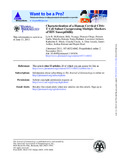| dc.contributor.author | McKinnon, LR | |
| dc.contributor.author | Nyanga, B | |
| dc.contributor.author | Chege, D | |
| dc.contributor.author | Izulla, P | |
| dc.contributor.author | Kimani, M | |
| dc.contributor.author | Huibner, S | |
| dc.contributor.author | Gelmon, L | |
| dc.contributor.author | Block, KE | |
| dc.contributor.author | Cicala, C | |
| dc.contributor.author | Anzala Aggrey O. | |
| dc.contributor.author | Arthos, J | |
| dc.contributor.author | Kimani, J | |
| dc.contributor.author | Kaul, R | |
| dc.date.accessioned | 2013-04-26T11:53:50Z | |
| dc.date.available | 2013-04-26T11:53:50Z | |
| dc.date.issued | 2011 | |
| dc.identifier.citation | J Immunol. 2011 Dec 1;187(11):6032-42 | en |
| dc.identifier.uri | http://erepository.uonbi.ac.ke:8080/xmlui/handle/123456789/17107 | |
| dc.description.abstract | The HIV pandemic disproportionately affects women, with most infections acquired through receptive vaginal sex. Although the target cells by which HIV establishes infection in the female genital tract remain poorly defined, it is known that immune activation results in CD4(+) T cells with enhanced susceptibility, as does expression of the mucosal integrin α4β7 and the HIV coreceptor CCR5. Blood and cervical cytobrush specimens were collected from female sex workers (FSWs) in Nairobi, Kenya. Genital infection diagnostics were performed, T cell populations were defined by multiparameter flow cytometry based on their expression of surface receptors relevant to mucosal homing and/or HIV acquisition, and cytokine production was assayed by intracellular cytokine staining. The integrin α4β7 was expressed on 26.0% of cervical CD4(+) T cells, and these cells were more likely to express both the HIV coreceptor CCR5 (p < 0.0001) and the early activation marker CD69 (p < 0.0001) but not CXCR4 (p = 0.34). Cervical Th17 frequencies were enhanced compared with blood (7.02 versus 1.24%; p < 0.0001), and cervical IL-17A(+) CD4(+) T cells preferentially coexpressed α4β7 and CCR5. Expression of IFN-γ and IL-22 was greater in cervical Th17 cells than in blood Th17 cells. In keeping with the hypothesis that these cells are preferential HIV targets, gp120 preferentially bound CCR5(+) cervical T cells, and cervical Th17 cells were almost completely depleted in HIV(+) FSWs compared with HIV(-) FSWs. In summary, a subset of Th17 CD4(+) T cells in the cervical mucosa coexpresses multiple HIV susceptibility markers; their dramatic depletion after HIV infection suggests that these may serve as key target cells during HIV transmission. | en |
| dc.description.uri | http://www.ncbi.nlm.nih.gov/pubmed/22048765 | |
| dc.language.iso | en | en |
| dc.title | Characterization of a human cervical CD4+ T cell subset coexpressing multiple markers of HIV susceptibility | en |
| dc.type | Article | en |
| local.publisher | Department of Medicine, University of Toronto, Toronto, Ontario, Canada | en |
| local.publisher | Department of Medical Microbiology, University of Nairobi, Nairobi, Kenya | en |
| local.publisher | Kenyan AIDS Vaccine Initiative, Nairobi, Kenya | en |


